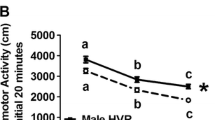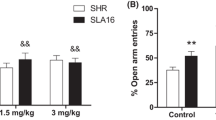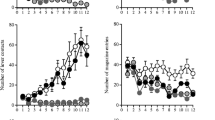Abstract
Rationale: Selective breeding of Sprague-Dawley rats has been used to generate a line of animals with very low swim-test activity (SwLo) in an attempt to model certain characteristics of depression. For comparison with the SwLo animals, a line bred for high swim-test activity (SwHi) and a non-selectively bred line (SwNS) have been generated. Previous studies using these lines suggested an inverse relationship between dopamine (DA) function in the brain and inactivity in the swim test. Objectives: The current experiments investigated the possibility that SwLo and SwHi rats show differences in central DA processes, as suggested by responsiveness to DA agonists. Results: The increase in ambulation produced by d-amphetamine (0.25– 1.0 mg/kg) was largest in SwHi rats and smallest in SwLo rats, with SwNS rats showing an intermediate response. Amphetamine levels in plasma and brain tissue were similar in SwHi and SwLo rats, indicating that pharmacokinetic differences were not responsible for the behavioral differences. Repeated amphetamine administration produced enhancement in the ambulation-increasing effects of this drug (i.e., sensitization), with significant enhancement seen in all three lines. Apomorphine in doses that stimulate postsynaptic receptors (0.25– 4.0 mg/kg) produced mainly increased sniffing behaviors in SwHi and SwNS rats and oral behaviors in SwLo rats, suggesting that the lines differ in proportions of D1, D2, and D3 postsynaptic receptors. Conclusions: The findings suggest that DA function differs in lines of rats selectively bred for differences in swim behavior, a feature that may make these lines useful for studying certain depressive symptoms that might be related to DA function.
Similar content being viewed by others
Author information
Authors and Affiliations
Additional information
Received: 26 September 1998 / Final version: 28 May 1999
Rights and permissions
About this article
Cite this article
West, C., Bonsall, R., Emery, M. et al. Rats selectively bred for high and low swim-test activity show differential responses to dopaminergic drugs. Psychopharmacology 146, 241–251 (1999). https://doi.org/10.1007/s002130051113
Issue Date:
DOI: https://doi.org/10.1007/s002130051113




